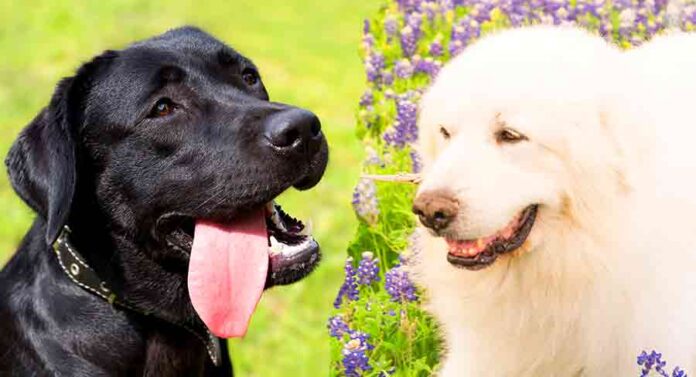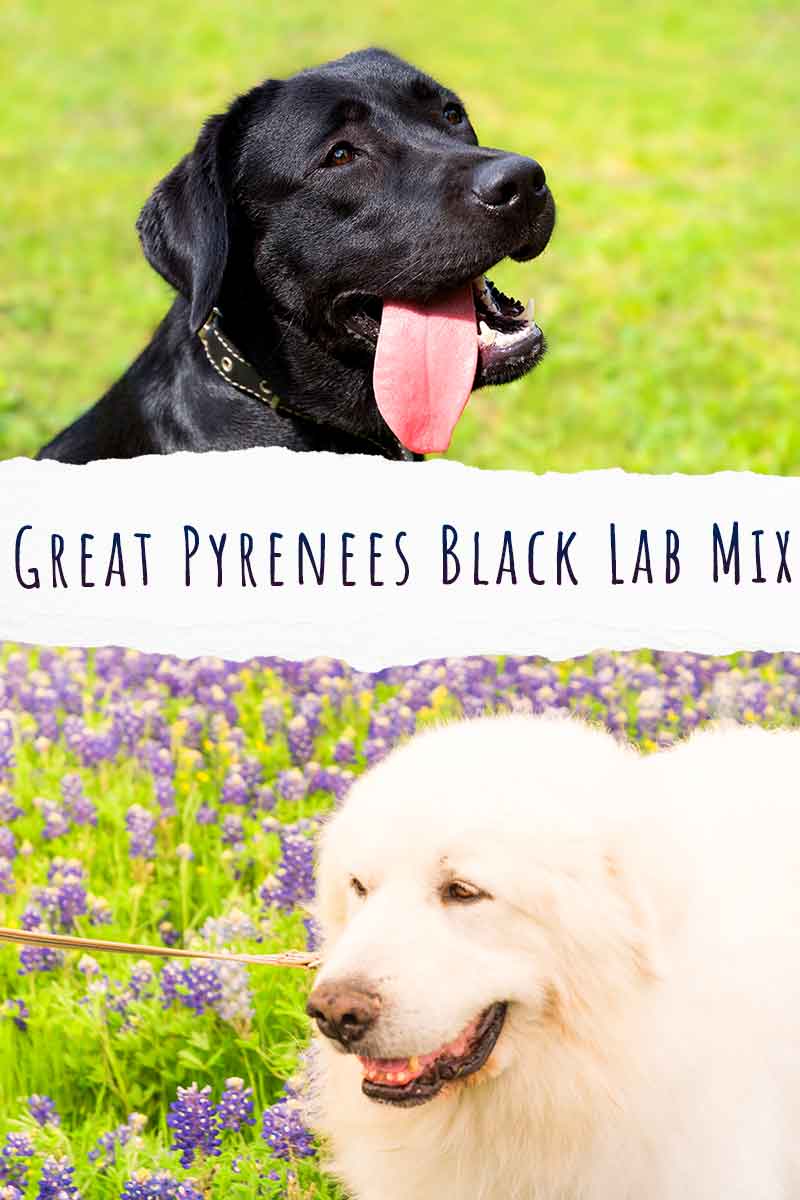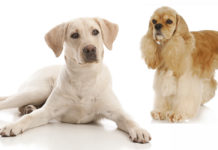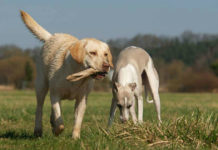Have you heard of the Great Pyrenees black Lab mix? In this guide, we explore the possibilities when these two rather different breeds collide. From looks and temperament, to health and exercise requirements.
The Great Pyrenees black Lab mix combines a traditional guardian breed affectionately know as ‘the polar bear dog’ with our all-time favorite retriever. They have some things in common, but some significant differences too. This means their puppies – also known as Pyradors – can be very variable, and it’s not wise to rely on one particular outcome. Let’s take a closer look.
Great Pyrenees Black Lab Mix: Breed At A Glance
- Popularity: Little-known
- Purpose: Companionship, therapy roles
- Weight: 65 to 100 pounds
- Temperament: Smart, affectionate, devoted
Great Pyrenees Black Lab Mix Breed Review: Contents
In this article we’re going to cover:
- History and original purpose of the Great Pyrenees black Lab mix
- Appearance
- Temperament
- Training and exercise
- Health and care
- Do black Pyradors make good family pets?
- Rescuing a Great Pyrenees black Lab mix
- Finding and raising a Great Pyrenees black Lab mix puppy
Origin of the Great Pyrenees Black Lab Mix
Breeding dogs from two different pedigrees to create ‘designer puppies’ has been gaining popularity since the 1980s. The Great Pyrenees black Lab mix is part of this phenomenon. But the separate histories of the Labrador and the Great Pyrenees can also help us better understand what it’s like to own Pyrador dog.
Labrador history
Labradors started out as gundogs. They were trained to accompany their owner on game shoots, and retrieve fallen birds from land and water. They quickly gained legions of admirers, because they were quick learners, successful workers during the day, and also laid back company back at home in the evening. These qualities transferred well into service dog training as well. And when owning pet dogs started to become widely attainable for lots of people, Labs were an obvious ‘good all round’ choice for lots of families. So it’s no wonder they’ve been America’s number one dog breed for nearly three decades!
Great Pyrenees history
Great Pyrenees are a centuries-old breed, developed to herd and protect sheep in the Pyrenees Mountains. Besides keeping the sheep in one place, they would also see off threats from poachers, wolves, and even bears. Their courage as guardians was so outstanding that King Louis XIV of France appointed them to protect his royal chateaux.
Sheep farmers in the United States started using Great Pyrenees to guard their flocks from the 1970s, and they’re still one of the most popular breeds for this purpose today.
What To Expect From A Great Pyrenees Black Lab Mix
With a Great Pyrenees black Lab mix, it’s impossible to predict exactly which traits each puppy will take from each parent. Physically they could end up very much like a Lab, a Great Pyrenees, or somewhere in between. Some puppies could get the Lab’s famous retrieving instincts, whilst others have strong guarding instincts, but mediocre retrieving skills. Even within a single litter, things like size, coat and temperament can vary a lot from puppy to puppy. So before you commit to a Pyrador cross, it’s important to consider all eventualities.
Great Pyrenees Black Lab Mix Appearance
Let’s start with the physical possibilities:
Size
Labradors are large dogs, weighing 55 to 80 pounds. Great Pyrenees are even larger, weighing 85 pounds and up! A Pyrador’s size is determined partly by the size of their parents, partly by their sex (males of both breeds tend to outgrow females) and partly their own unique makeup. The overall shape of both dogs is pretty similar – broad and well-muscled, with kind eyes and ears that fold down the side of their head.
Coat
Labs and Great Pyrenees both have thick, waterproof double coats, ideal for working outdoors all year round, in harsh climates. They both shed all year round, and ‘blow their coat’ (shed even more heavily!) twice a year to adapt to the seasons. The Pyrenees’ coat is longer and fluffier than a Lab’s and features a pronounced ruff and pantaloons – longer hair on the chest and legs. The length of a Great Pyrenees black Lab mix’s coat could match their Lab parent, their Pyrenees parent, or be somewhere in between.
Color
A big question about a Great Pyrenees black Lab mix is, what color will they turn out? A black Lab is obviously black, and the Great Pyrenees is famous for being white!
In fact, genetically Great Pyrenees are actually very, very pale red. And black Labradors can silently carry the genes for brown or red coats too. So the color of Pyrador puppies from a black Lab parent will depend upon whether that Lab only has genes for black pigment to pass on. If so, those genes have powerful genetic dominance, and the result will be black puppies. Butif the Labrador is silently carrying genes for other colors too, their Pyrador puppies could end up white, or even a soft brown or red.
Great Pyrenees Black Lab Mix Temperament
Next let’s see how their dual heritage affects a Pyrador’s personality. Labs and Great Pyrenees originally served quite different purposes, and they have different temperaments which made them suited to those roles. It’s impossible to predict which attributes any given puppy will receive, or to guarantee that they’ll only inherit the traits you perceive as most desirable in each breed!
Both breeds adore their families, and are noted for being patient and gentle with children. But whilst the Great Pyrenees tends to be disinterested in strangers, the Labrador sees everyone as a new friend. There are pros and cons to both, but if you’re relying on one or the other, then this mix might not provide.
In their working role, Labradors also needed to be focused on their handler, and easily motivated to work as part of a dog-human team. All modern Labs are bred from ancestors who excelled in this. But Great Pyrenees traditionally worked alone – spending long days watching sheep, and making their own judgements about how to deal with threats. The result is that Labradors are much easier to train than Great Pyrenees! But a Pyrador won’t necessarily be an easier to train version of the Pyrenees – they could inherit the Pyrenees’ strong instinct for independent thinking!
Great Pyrenees Black Lab Mix Socialization
It doesn’t take much to convince a Labrador to trust new people. But it still depends upon having socialized them well at a young age. For Great Pyrenees, whose natural guarding instincts tell them to be wary of unfamiliar people and animals, socialization is even more important.
So it’s important to socialize a Pyrador puppy thoroughly and methodically from the time you bring them home, until they are 12 weeks old. During this window they will be very receptive to forming positive associations with things, if you introduce them gently and pair them with lots of treats. These positive associations will give them confidence, and minimize fearfulness, as they get older.
Next let’s look at what other training the Great Pyrenees black Lab mix will need.
Training and Exercising Your Great Pyrenees Black Lab Mix
Whether your Pyrador trains easily like a Lab, or requires more patience like a Pyrenees, there are some training basics you can’t miss.
All dogs need to be potty trained. Labrador puppies are notorious chewers, so crate training them for when you’re out is a good way of saving your furniture. All Pyradors are big dogs too, so it’s important to teach them good manners around people. If a Pyrador jumps up at an unprepared person, that person is likely to end up on the floor! In a similar them, you’ll want to teach your Pyrador to walk calmly on a loose leash. A Pyrador that pulls ahead will be miserable to walk, and could easily damage the muscles in your shoulder too.
These training guides elsewhere on the site can help you get started with all of these skills:
- How To Potty Train A Puppy
- Crate Training Your Labrador Puppy
- No More Jumping Up: How To Stop Your Labrador Leaping On People
- Walking Your Labrador on a Loose Leash
- How to Train Your Lab to Sit in Easy Steps
Over on our Dogsnet site, our training courses will also teach you how to establish them step-by-step, with real-life support from the training team in our student forum.
A Pyrador with a very Lab-like temperament is likely to enjoy training as a form of mental stimulation for their whole life. Activities like field work and advanced obedience are a great outlet for their natural work ethic.
Exercise
Working Labradors and Great Pyrenees have traditionally been accustomed to quite different amounts of activity. Labradors are dogs of action – Follow stuff! Find stuff! Return stuff! Repeat! Great Pyrenees on the other hand had to stay in place, and look at sheep. It’s a very different pace of life.
Due to these differences, a Great Pyrenees black Lab mix might be satisfied with less than an hour of exercise a day, or they might become bored and destructive on any less than two. So again, if the amount of time you want to spend exercising your dog is fixed and important, this mix might not be right for you.
Great Pyrenees Black Lab Mix Health and Care
Since Labs and Great Pyrenees are both large dogs, they are more vulnerable to joint diseases such as hip dysplasia and elbow dysplasia. These diseases are painful, and can ultimately make a dog lame. They have both genetic and environmental causes, you can protect your puppy by
- Buying them from a breeder who health tested both parents, and has certificates to prove they’re free from joint disease.
- Feeding them an age- and breed- appropriate diet, so they don’t gain weight faster than their joints can support.
- Limit how much leash walking and stair climbing they do while they’re still growing.
And keep them at a healthy adult weight so as not to strain their skeleton.
Other Breed Specific Issues
Great Pyrenees also have a higher than average frequency of
- the eye disease canine multifocal retinopathy
- the neurological conditions degenerative myelopathy and neuronal degeneration
- and thyroid disease.
Labs are more than averagely prone to
- degenerative myelopathy
- exercise induced collapse
- progressive retinal atrophy, which causes blindness
- and thyroid disease.
Breeding dogs from these breeds should be cleared free of these diseases before mating, either by veterinary exam, or DNA test. Look for breeders who advertise which health tests they’ve commissioned, and are happy to share the results with you. Avoid breeders who either don’t health test, or who claim the tests have been done, but keeping making excuses why they haven’t forwarded the results.
Life Expectancy
Labradors live for 12 to 13 years on average, although some individuals have been recorded reaching their 19th birthday! Great Pyrenees are a giant breed, and like all extra large dogs they tend to have a shorter than average lifespan. Pyrenees live 9-10 years on average, and the oldest recorded individuals were 16 years old.
A healthy Pyrador will probably achieve a lifetime somewhere between their parents’. So anywhere in the region of 9 to 13 years. The average life expectancy of all dogs taken together is 11 years and 3 months, so the Pyrador is more or less bang on average.
Shedding and grooming
Labs and Pyrenees both shed copiously, all year round. So a Pyrador will too. In spring and autumn the thickness and texture of their coat changes to match the season, and they shed the last season’s coat even more rapidly than usual. So there will always be shed hair visible in your home, and twice a year there will be drifts of it.
To manage their shedding, brush them a couple of times a week, and use a deshedding tool like a Furminator to loosen and remove dead hair. Besides this, the Pyrador’s coat is actually pretty low maintenance. Both Pyrenees and Labs have all-weather coats that can be damaged by clipping or excessive washing. So unless they’ve rolled in something awful, they rarely need a bath.
Are Great Pyrenees Black Lab Mixes Good Family Pets?
Labs and Pyrenees are both popular with families individually. The Great Pyrenees in particular are described as gentle and patient with children in the family, and look upon them as small members of their ‘flock’ who need looking out for. Bear in mind that this is very sweet, but it can result in misplaced protective behaviors – for example if someone they don’t know moves in to hug or play with your child.
If you’re already juggling the demands of a young family, you should also think about whether you have the time to devote to teaching a large dog good manners. Dogs from guardian breeds, including the Great Pyrenees, tend to have long puppyhoods, take longer to reach emotional maturity, and retain some puppylike behaviors for their whole lives. These qualities are tied into the strong guarding instinct. But they mean that raising a Pyrador to maturity can feel like a long slog.
Similar Mixes
If you ultimately decide that now is not the right time to raise or rehome a Pyrador, one of these mixes might be a better match for your family:
- Labernese – A Complete Guide To The Bernese Mountain Dog Lab Mix
- Australian Shepherd Lab Mix – A Complete Guide To The Aussiedor Dog
- Great Dane Lab Mix Breed Information Center – Discover The Labradane
- Newfoundland Lab Mix
But if your sold on the charms of a black Labrador Great Pyrenees mix, let’s look at finding one next.
Rescuing a Great Pyrenees Black Lab Mix
Labradors are the United States’ most popular dogs. Which means there are a lot of them, including within the shelter population. There are even rescue organizations which specialize in rehoming Labs and only Labs! Labrador mix dogs are also common in rescue shelters, because Labs are so abundant. However, you might have to be patient if you’re determined that you only want to adopt a Pyrador. It’s a very specific combination, and as far as we’re aware at the time of writing, there aren’t any shelters who specialize in them.
Finding a Great Pyrenees Black Lab Mix puppy
On the other hand, finding Pyrador puppies for sale is relatively easy, especially if you’re willing to travel. However, this mix is at risk of being exploited by bad breeders, and it’s unlikely that all the puppies offered for sale have been raised carefully by decent people. Puppy mills in particular try to raise litters of desirable puppies at the lowest cost possible, in order to secure the highest profit. Unfortunately puppies raised in this environment are more likely to have behavioral problems and lifelong health conditions.
Our guide to spotting a bad breeder can help you avoid heartache.
Is A Great Pyrenees Black Lab Mix Right For Me?
A black Pyrador isn’t for everyone. Here’s a run down of their pros and cons:
Cons
- Take up a lot of space – not suitable for small homes.
- Long puppyhood – the most gruelling period for lots of dog owners.
- Their parents have some contradictory instincts – it’s impossible to predict which your puppy will take after.
- Will shed A LOT.
Pros
- Likely to be gentle and patient with children.
- May not need a lot of exercise, relative to their size.
- Relatively free from health problems related to body shape.
Your Great Pyrenees Black Lab Mix
What do you think of the Great Pyrenees black Lab mix? Do you already share your life with one? We’d love to hear all about them in the comments below!
Readers Also Liked
- Black Lab Chow Mix
- Black Lab Rottweiler Mix
- Lab Mix: A Guide To Labrador Cross Breeds
- Bloodhound Lab Mix
References And Resources
- Adams et al. Methods and mortality results of a health survey of purebred dogs in the UK. Journal of Small Animal Practice. 2010.
- Great Pyrenees Club of America.
- Official Standard of the Great Pyrenees. American Kennel Club. 1990.
- Official Standard of the Labrador Retriever. American Kennel Club. 1994.
- Orthopedic Foundation for Animals.
- Wauthier et al. Using the mini C-BARQ to investigate the effects of puppy farming on dog behaviour. Applied Animal Behavior Science 2018.
The Labrador Site Founder
Pippa Mattinson is the best selling author of The Happy Puppy Handbook, the Labrador Handbook, Choosing The Perfect Puppy, and Total Recall.
She is also the founder of the Gundog Trust and the Dogsnet Online Training Program
Pippa's online training courses were launched in 2019 and you can find the latest course dates on the Dogsnet website





















We “lucked” into a black lab- pyr male. We knew the mom and dad, both of which had great traits. Charlie is living his best 150lb bear-like life on a farm with cattle and chickens. He moves easily from farm to city to cottage and protects everyone around him (from the coyotes and foxes) while making friends with every human and dog he can find. We definitely got the best traits from both sides of the mixes and are stuck on the mixed breed. We are hoping to find a playmate and apprentice for him as he gets a little longer in the tooth. We are so glad he found us. We are better for him being a part of our family.
How lovely, Charlie sounds awesome 🙂 Thank you for sharing his story!
I adopted a 4 month old Black Lab/Pyrenees mix. She looked like a big black Lab (80 pounds) with slightly longer and softer coat than a Lab (but nothing like a Pyrenees coat). I did her genetic testing and she was a pure bred on both sides.
She was born on a farm and was an outside dog. She spent her first 4 months with kids, dogs, cats, goats and chickens so she was already socialized when I got her. I didn’t have to house break her because she was used to going outside. In fact I had to teach her to come through a door and walk on carpet. She and I became an animal assisted therapy team visiting hospitals for 10 years until COVID shut that down. She had no medical issues until she died suddenly last year at 11 years, 4 months from what appeared to be a stroke or aneurysm. She never met a stranger, was easy to train, gentle and loving. Best dog I ever had – so much so that I do not want another dog as it would never be as awesome as she was.
We’ve had this Lab/Pyrenees mix for 13+ years. Payton is her name. While she has a extra fury coat, it’s not the vast abundance of what a Pyrenees would have… thank goodness. She is white but has very light highlights within her Coat. Her disposition, she likes people and other Dogs, but she LOVES kids ..!! Thank you for such a great article on these Pups. I wish there was a way to enclose a photo.